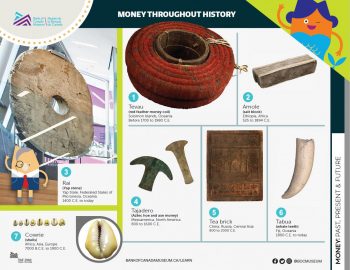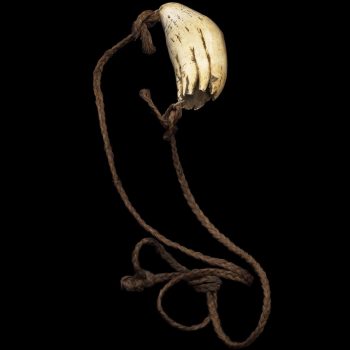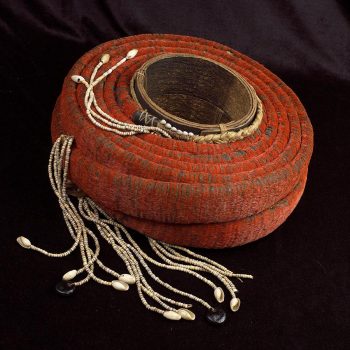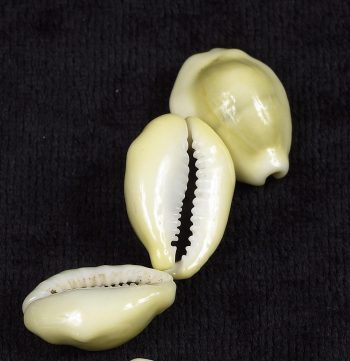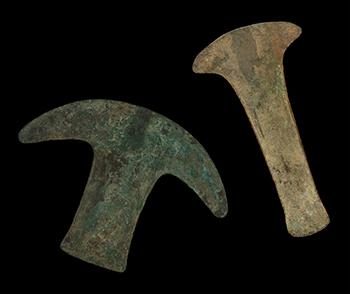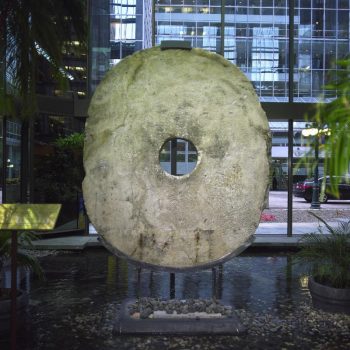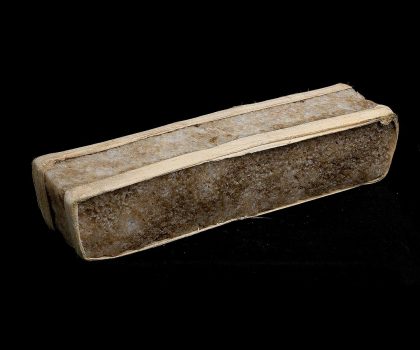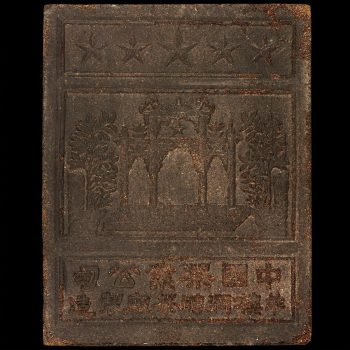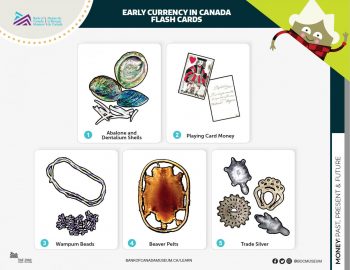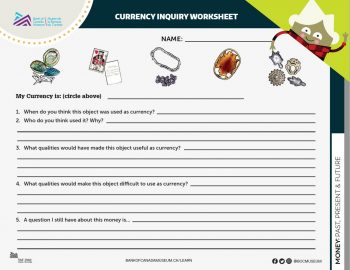
Explore the history of money in Canada and around the world using an inquiry approach.
Overview
Using the inquiry method, students will explore the characteristics and role of money in our society: in the past, present and future. To help guide the discussion, the lesson surveys the history of money around the world and in Canada. This includes an inquiry activity exploring money used in Canada before and after European contact, including the fur trade.
Big idea
Money has taken many different forms throughout history. It began mostly as commodity currency but has transitioned to fiat currency.
Total time
Approximately 60 minutes
Grade levels
Grades 5 to 10; Elementary Cycle Three to Secondary IV
Subject areas
Social Studies
- past and present: Changes in everyday objects
- heritage and identity: Early societies to 1500 C.E.
- heritage and identity: Communities in Canada, past and present
- heritage and identity: Interactions of Indigenous peoples and Europeans
- french and Canadian society during the fur trade
- economic situation and the fur trade
Economics
- history of money
- characteristics of money
- commodity versus fiat money
Learning objectives
Students will:
- discuss the role of money in society
- consider alternatives to fiat money and different forms of commodity currency used throughout history
- compare different forms of Canadian commodity and fiat money
- explore the five characteristics of modern-day money
Materials
Classroom supplies
- printer and paper
- scissors
- pens or pencils
- whiteboard or chart paper and markers
- projector or display screen hooked up to a computer (optional)
Handouts and worksheets
- Download the activity and answer sheet.
- Print the resources on regular paper:
- Illustration (Money Throughout History)—one copy per student, or display to review together
- Worksheet (Currency Inquiry)—one per student
- Flash cards (Early Currency in Canada)—enough for one card per student
- Answer sheet (Currency Inquiry)—one copy per pair of students, or display to review together
- Cut out the flash cards and set them aside for Activity 2.
Activity 1: Discussion
This activity opens the class with a discussion about money and shows some historical examples of commodity currencies from around the world.
Time
20 minutes
1.1 Opening discussion
Explain to your students that today they will be looking at money used in the past to help them understand the ways we pay today, such as bank notes and coins and debit cards.
Ask the students:
- How would you explain money to someone like a small child who has never seen it before?
- What questions do you have about money?
If you would like, record their questions, answers and discussion notes on the whiteboard or chart paper. Use them in a later discussion or research project.
Explain that money helps us trade for goods and services. It acts as a medium of exchange, which means it is recognized and commonly used by everyone. This makes it easier to get goods or services than it would be by bartering or trading.
1.2 Display of international and historical money
Money has a long history in many civilizations, but its origins may surprise you. Display or hand each student a copy of the Money Throughout History illustration to show some examples.
If time allows, have your students guess some of these objects to prepare them for the inquiry activity on Canadian money that follows. If you are displaying the illustration, zoom in on each picture (so the captions are hidden), then zoom out to reveal the captions with the answer.
Share the following information about the objects with your students:
Tabua (whale teeth)
Sperm whales have the largest teeth of any whale. As early as 1800 C.E., their teeth were used as a valuable currency on the island of Fiji. The tabua were first rubbed smooth and then stained yellow with spices or smoke. Often a hole was drilled at either end and a braided cord was attached. Tabua are still used as gifts of honour or to commemorate weddings.
Tevau (red feather money coil)
This currency is from the Santa Cruz islands, which are part of the Solomon Islands in Oceania. The coils were made with the tiny feathers of the Scarlet Honeyeater bird. The island’s Indigenous Nandö people would catch the tiny birds, plucking a few feathers and then setting them free. It took between 50,000 and 60,000 feathers to make one coil. The coils were traditionally used for purchasing goods or services or as a wedding gift. They have not been used on the island since the 1980s.
Tajadero (Aztec hoe and axe money)
While the Aztecs valued silver, they never used it as currency. According to Spanish reports at the time of the conquest, copper and tin axe-shaped objects were used as a form of currency. These copper hoes and axes—too fragile to be used as tools—were first made in about 800 C.E.; however, it is likely they were only used as money after European contact. The copper was often mixed with arsenic to make the metal light in colour.
Rai (Yap) stones
From the Pacific island of Yap, rai ranged from a few centimetres to four metres in diameter. They were used, beginning over 500 years ago, for significant transactions. Quarried on the island of Palau, rai were transported to Yap on rafts, crossing 500 kilometres of open ocean. These difficult voyages were part of what gave rai their value. These stones did not physically change hands because they were often too big. People simply agreed that the ownership changed. Rai are still in use today for marriages and land transactions.
Amole (salt brick)
Before iceboxes or refrigerators, people used salt to preserve food. Salt was quite hard to come by, made for the most part by evaporating sea water. Because salt was rare and valuable, many different cultures used it as money. It is believed the ancient Romans paid their soldiers with salt—or at least paid them a sum of money for acquiring salt. This pay was known as salārium and is the root of the English word “salary.” This salt brick is from Ethiopia and they were used there until the 1930s.
Tea bricks
These were used as currency in different parts of Central Asia from the 9th to 20th century C.E. The use of tea as a commercial trade item began with demand for Chinese tea by Russian nobility. Initially, dried leaves were shipped along the silk route; however, over time people found it more convenient to process the tea and form it into solid book-sized bricks. Eventually, tea bricks became an accepted medium of exchange that could be used as easily as silver or other trade items. Twenty bricks could purchase a horse, and twelve could buy a sheep.
Explain to your students that these objects were used as a medium of exchange in various time periods and in various part of the world. Before coins and bank notes were invented, people used many different types of commodity currency.
Some of these objects also had important spiritual or cultural purposes for the communities that used them. Some began to be used as currency only after contact with other civilizations or peoples.
The earliest examples of fiat currency that resemble the money we use today began over 2,500 years ago. Humans began using metal coins as money around 600 B.C.E. in Lydia (now Turkey), and the first paper money was issued in China around 700 C.E. to make large transactions possible.
Activity 2: Early currencies in Canada
In this activity, students will discover the characteristics of money by guessing and comparing the use of different Canadian historical currencies, including those used during the fur trade.
Time
40 minutes: 20 minutes for individual and group work, and 20 to review the correct answers
2.1 Hands-on activity exploring early currency in Canada
This inquiry worksheet activity will help students explore different currencies used before and after European contact in what is now Canada. Some of them were used for a few decades or centuries, and one was used for over a millennium.
Introduce the activity to your students. Assign each student one of five objects used as a commodity currency sometime in the history of Canada.
Hand out to each student:
- one Early Currency in Canada flash card (their object)
- a copy of the Currency Inquiry worksheet
2.2 Compare using a Venn diagram
Ask students to find a partner and compare and contrast their two objects using the Venn diagram on the back side of the worksheet. They should aim for two or three items for each circle and in the overlapping space in the middle. Allow 5–10 minutes for this step.
2.3 Discuss worksheet answers
Ask a few students to share their guesses on the worksheet. Then give each pair of students who worked together on the Venn diagram a copy of the Currency Inquiry answer sheet, or display it for the class. Go through the objects in the order of the numbers on the flashcards. The objects are ordered chronologically, so you could create a timeline on the whiteboard or chart paper if you like.
Have students note what information about their object they guessed correctly. If time allows, students can add information from the answer sheet to their worksheet. As you are reviewing the answers, look for any curious ideas and ask your students to further explain their guesses and rationale.
Remind your students that there were intricate systems of trading and exchanging goods long before European settlement in North America.
- Some Indigenous communities used objects as a common currency or had trade networks of many miles for goods.
- Before a Canadian fiat currency was introduced, settlers used coins they may have already had on hand—such as Spanish-American, French, British and Dutch coins. With no national currency or locally made coins, early Canadian settlers also relied on commodity currencies for trading at times, such as the objects explored in the worksheet.
- It wasn’t until 1858 that Canadian money followed the same decimal and dollar format of the United States. The first coins for the Dominion of Canada were minted in 1870.
2.4 Discussion
Ask students to share what they think their objects have in common—the items in their overlapping circles of the Venn diagram. Write these common features on the whiteboard or chart paper or note them for later.
Then, explain to your students that there are five characteristics of modern-day money. These characteristics help explain our progression from the various commodity currencies used throughout history to the coins and bank notes we use today.
Read each of the five characteristics aloud or write them on the whiteboard:
- Durable: Money needs to stand up to weather and time and be non-perishable. Otherwise, people will be reluctant to invest in this currency. Metal coins are a perfect example of currency that is durable.
- Portable: Money has to be easy to carry long distances. Tea is an example of this. It was made into bricks for easy transport along the Silk Road.
- Divisible: Money must be easily divided into smaller parts to make up a larger or smaller value. An example of this is cowrie shells or other shell currency that could be easily divided.
- Hard to counterfeit: Currency should be uniform to prevent counterfeiting. Everyone must have confidence in it, accept it and recognize its worth. Polymer bank notes have security features to prevent counterfeiting, which encourages trust and use of this currency.
- Rare but not too rare (in limited supply): The material a currency is made from should be rare but not so rare as to prevent an adequate supply. An example of this is wampum beads. They were quite difficult to produce and were traded long distances, making wampum not easily accessible to all. When the Dutch started to make wampum beads in a factory, they became more accessible, which devalued them as a currency.
Ask the students to reflect on their worksheet answers and group comparisons.
- Did they bring up any of these characteristics in their discussion about their objects?
- Which one of their two objects would be the better money? Why?
- Use the five characteristics above to help determine if any other object would work well as a commodity currency.
Before Canada’s central bank was founded in 1935, bank notes were created by many different banks across the country. This made the different fiat currencies hard to control. When the Bank of Canada was created, it became the only producer of the standard Canadian bank notes we use today.
Over the years, money has also changed forms with technology, notably with computers and digital forms of money today. For example, the money or stored value you have in a bank account can now be exchanged using a debit card or other payment method.
Close the discussion by explaining the evolution of our money from a commodity currency to a fiat currency. Review with students the concepts of commodity and fiat currencies, as well as how each is a medium of exchange.
- Our currency today is an example of a fiat currency, as are most of the world’s currencies in official use. The Canadian dollar only has value because we trust that it does, and we agree together on the value. For example, a modern $5 bank note costs far less than $5 to produce—production and manufacturing only cost around 42 cents. We decide that a bank note or a coin represents its face value—that is, the value it is labelled.
- Knowing this, which of the early Canadian examples discussed today are fiat currencies? Which are commodity currencies? (Answer: the only fiat currency is the playing card money—the rest are commodity examples.)
Conclusion
To close the lesson and check for understanding, ask your students the following questions:
- If someone didn’t have bank notes and coins to use as money, what could they use instead?
- What object would you choose as money?
- With increasing technology, what do you think money will look like in the future?
Key takeaways
- Money has taken many different forms throughout history. It began as commodity currency.
- Objects were used as currency throughout history because they shared characteristics that made them useful as a medium of exchange.
- Early Canadian settlers used many forms of commodity and fiat money.
- There are five characteristics of modern-day money.
Extensions
- Connect past forms of money with future ones by reviewing our Money FAQ with your students. Topics include the production, origins and history of money used today.
- For more information and summaries of the history and role of money, check out the series Money and Monetary Policy in Canada, specifically the modules on money’s functions and characteristic and a historical look at money.
- If you’re exploring Canadian history, you may want to view the money examples in more detail using the Canadian Encyclopedia. You can also look up additional examples used throughout Indigenous, early settlement, pre-Confederation] and contemporary Canadian history.
- Money is not the only thing of value in the world. Have a conversation with your students about other things our society treasures, some of which we cannot really put a dollar value on.
We want to hear from you
Comment or suggestion? Fill out this form.
Questions? Send us an email.
